Research
Atmospheric Chemistry and Composition Laboratory (ACCL)
An interdisciplinary laboratory for atmospheric chemistry and composition

In the atmospheric chemistry and composition laboratory, ACCL, we combine laboratory and field measurements, remote sensing, and multi-scale physical modeling in addition to economic and societal assessment models to investigate convergent transdisciplinary questions.
About Us
OUR TEAM
Yasin Elshorbany, Team Lead
GRADUATE STUDENTS
ALUMNI
- Sydney Kaylor, honor thesis 2022
- Sarah Mixson, honor thesis 2021
- Kelli DeJa, honor thesis 2020
- Summer Sanderfield, RA, TA (2020-2022)
- Hannah Kapper, RA, TA (2019-2021)
- Robin Rives, RA (MS 2022)
- Callie Mills, RA (MS 2021)
- Nadeen Khawaja, TA (2020)
- Dominique Gallaery, RA (2020)
CURRENT COLLABORATORS
Areas of research
Convergent Interdisciplinary Socioeconomic Climate Studies
We currently investigate the socioeconomic impact of climate change using two main modeling systems, the Policy Analysis for the Greenhouse Effect (PAGE ) and the Infrastructure Planning Support System (IPSS):
- PAGE IAM: Policy Analysis for the Greenhouse Effect (PAGE) integrated assessment model (IAM),
on top of the @Risk package. This system is used for large scale global assessment
of climate on infrastructure. PAGE predicts GMST and [GHG] as prognostic variables
on an annual time step, representing complex climate feedbacks as statistical emulators
(Figure 1). Emulators are statistical regressions of the bulk effects of a process
based on simulations from full-physics GCMs and LSMs. PAGE predicts the global average
atmospheric concentration of CO2, CH4, N2O, high warming potential gases, sulphate
aerosols, and all other GHGs combined. Anthropogenic GHG emissions come from the
RCPs (van Vuuren et al., 2011) and [CO2] depends on land uptake, ocean uptake, and
the PCF. Land uptake represents the balance between photosynthetic uptake by plants
and respiration into the atmosphere due to the decay of dead organic material. PAGE
has several coupled feedbacks, resulting in a non-linear response to anthropogenic
GHG radiative forcing.
- IPSS: The Infrastructure Planning Support System (IPSS) is an integrated system that determines vulnerabilities to climate change, the costs associated with these vulnerabilities and possible adaptation strategies, and finally, the risk associated with adopting either a proactive adaptation strategy or a reactive “business-as-usual” strategy. We integrate the IPSS system with sustained stakeholder engagement to discover new ways of integrating multi-scalar, interdisciplinary datasets. This interdisciplinary approach is compatible with the new IPCC recommendation to mitigate the climate change consequences in Coastal cities (IPCC, 2019).
Earth System Modeling
We use multiscale models that range from explicit 0D box models to 3D models. We use the following models for atmospheric chemistry investigations:
- 0D box model:
We use box models to investigate and elucidate the atmospheric chemical mechanisms during extensive field and laboratory measurements. In these simulations, we use explicit chemical mechanisms such as the master chemical mechanism (MCMv3.3), which contains ~20,000 reactions and ~8000 species. Output from these explicit models help us understand the radical budget in the atmosphere such
Figure 3: Average daytime fluxes of the radical sources and sinks for the city of Santiago de Chile calculated by the MCM model during winter (bold) and summer (between brackets). Units are in ppbv h-1. HONO net contribution, 82% (52%) in this diagram is slightly lower than in the text because [HONO]PSS is calculated here using [OH] calculated by the MCM (3–4% higher). Adopted from Elshorbany et al., 2010.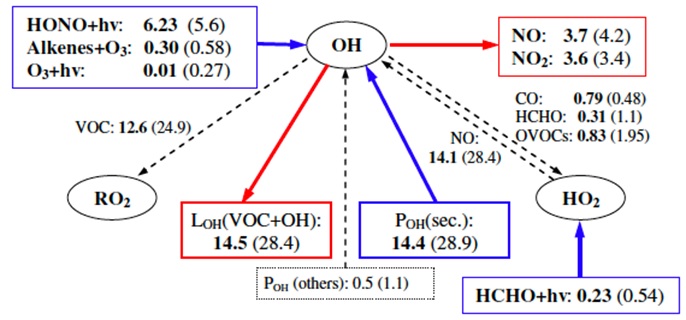
- 3D CTM:
We use 3D chemical transport models (CTM) to investigate the global impact of new or important chemical mechanisms. W currently use the CESM model in the CTM mode for these applications.
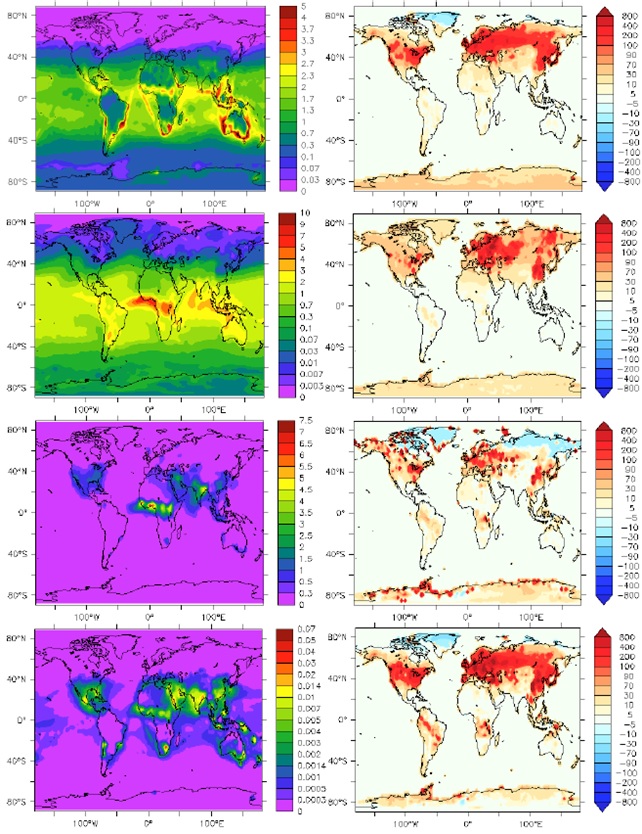
Figure 4: Average simulated OH (from top to bottom) (106 molecules cm−3), H2O2, HNO3, H2SO4 (ppbv) near the surface from the reference run (base_S1, left panels) and their relative enhancements (%) due to the implementation of realistic HONO levels in the model (S1, right panels) in January. Adopted from Elshorbany et al., 2014a.
Simulated OH levels using a computation efficient module implemented in the NASA GEOS5 CCM model is also presented below: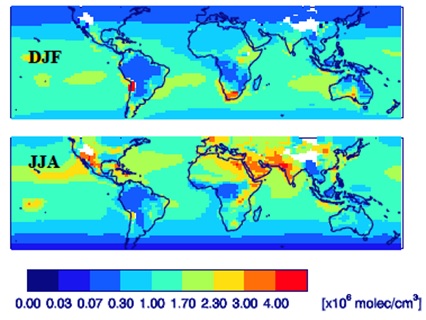
Figure 5: Seasonal mean (1988–2007) OH (⇥106 molecules cm−3) for the Base scenario for December–February (DJF) and June–August (JJA) at 850 mbar. Adopted from Elshorbany et al., 2016
-
Earth System Models (ESM): We also use CESM as a fully coupled atmosphere-land-ocean general circulation model (GCM) to investigate chemistry-climate interactions.
Remote Sensing of Atmospheric Composition
We use several remote sensing products to validate our 3D model output.
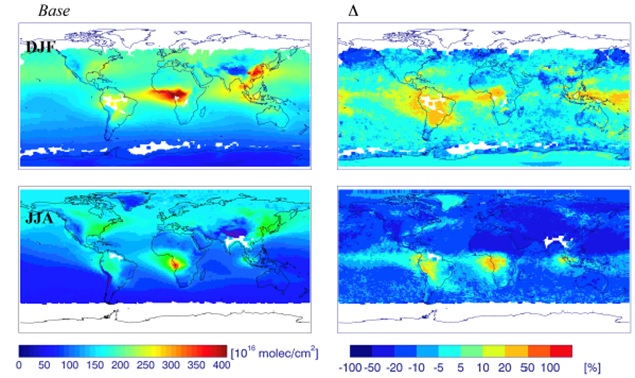
Figure 6: Seasonal mean (2006–2007) CO columns (⇥1016 molecules cm−2) from the Base scenario (left column) and the relative difference (%; (Base observations)/observations; right column) with MOPITT data. Adopted from Elshorbany et al., 2016.
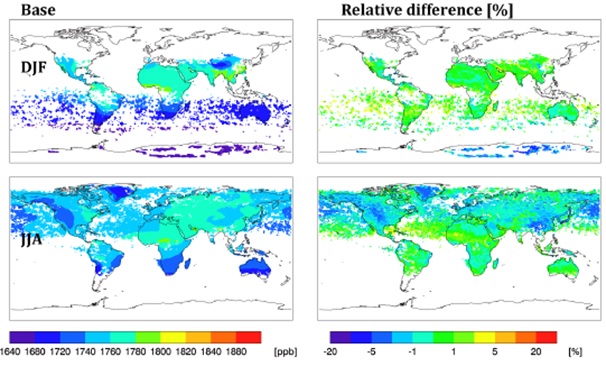
Figure 7: Seasonal mean (2004) methane dry column (ppbv; left column) from the Base scenario and the relative difference (%, (Base observations)/observations; right column) with SCIAMACHY data. Simulated methane levels are gridded to the spatial resolution of the SCIAMACHY data. Adopted from Elshorbany et al., 2016.
In-situ Field and Laboratory Measurement of VOCs and Nitrogen Oxides (NO and NO2)
The ACCL is specially equipped to do NIST (National Institute of Standardization) and EPA (Environmental Protection Agency) TO-17 method-certified quantitative analysis of volatile organic compounds (VOC) using thermal desorption (TD) gas chromatography (GC) mass spectroscopy (MS) techniques.
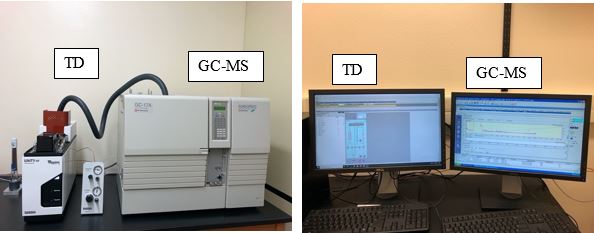
Figure 8: The thermal desorption, Gas Chromatography Mass Spectroscopy system in the ACCL.
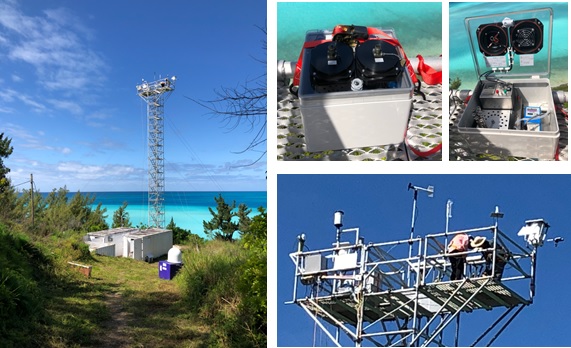
Figure 9: The VOC automatic sampling unit on top of the measurements tower in Bermuda.
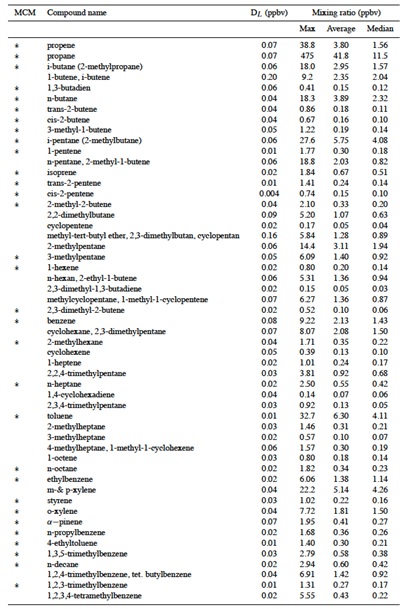
Table 2: List of the VOCs measured during the summer campaign in Santiago de Chile. * Compounds included in the MCM model. Adopted from Elshorbany et al., 2009.
Measured VOC can be used to constrain explicit box models to calculate the radical budget and evaluate the atmospheric oxidation capacity (see Figure 3).
Nitrogen Oxides are measured using the Teledyne T200UP Photolytic NO/NO2/NOX Analyzer. The instrument uses a patented high-efficiency Blue Light Converter (BLC) coupled with state-of-the-art microprocessor technology to provide a true measurement of ambient nitrogen dioxide (NO2). The BLC includes the latest technology in high-powered LEDs and a Teflon cell with reflective properties that increase the overall conversion efficiency, which allows for better speciation of lower NO2 levels. The Instrument detection limit is ~50 ppt.
projects & publications
PROJECTS
NSF funded Project: Collaborative Research: An Investigation into Daytime HONO Chemistry in the Marine Boundary Layer
Relationships Between Air Quality, Health Outcomes, and Socioeconomic Impacts of the COVID-19 Pandemic in Florida. This interdisciplinary project is funded via the USF’s Pandemic Response Research Network (PRRN).
The Relation Between Atmospheric Aerosol Concentrations and COVID-19 Infection Rates. This interdisciplinary project is in collaboration with Morsani College of Medicine - funded via a USF's Creative Research Grant.
SELECTED PUBLICATIONS
- Elshorbany, Y., Ziemke, J., Strode, S., Petetin, H., Kazuyuki Miyazaki, Isabelle De Smedt, Kenneth
Pickering, Rodrigo Seguel, Helen Worden, Tamara Emmerichs, Domenico Taraborrelli,
Maria Cazorla, Suvarna Fadnavis, Rebecca Buchholz, Benjamin Gaubert, Néstor Rojas,
Thiago Nogueira, Thérèse Salameh, and Min Huang, Tropospheric Ozone Precursors: Global
and Regional Distributions, Trends and Variability, Atmos Chem. Phys., egusphere-2024-720,
2024.
- Elshorbany, Y.; Mixson, S.; Marcum, L.; Salemi, J.L. The Relation between Atmospheric Aerosol Concentration
and SARS-CoV-2 Variants’ Infection and Mortality Rates in the United States: A Remote-Sensing
Perspective. Sustainability, 16, 3381. https://doi.org/10.3390/su16083381, 2024.
- Rodrigo J. Seguel, Lucas Castillo, Charlie Opazo, Néstor Y. Rojas, Thiago Nogueira,
María Cazorla, Mario Gavidia-Calderón, Laura Gallardo, René Garreaud, Tomás Carrasco-Escaff,
and Yasin Elshorbany, Changes in South American Surface Ozone Trends: Exploring the Influences of Precursors
and Extreme Events, ACP, https://doi.org/10.5194/egusphere-2024-328, 2024.
- Iturrate-Garcia, M., Salameh, T., Schlauri, P., Baldan, A., Vollmer, M. K., Stratigou,
E., Dusanter, S., Li, J., Persijn, S., Claude, A., Holzinger, R., Sutour, C., Macé,
T., Elshorbany, Y., Ackermann, A., Pascale, C., and Reimann, S.: Towards a high quality
in-situ observation network for oxygenated volatile organic compounds (OVOCs) in Europe:
transferring traceability to the International System of Units (SI) to the field,
EGUsphere, https://doi.org/10.5194/egusphere-2024-2236, 2024.
- Youfeng Wang, Yuting Zhu, Chunxiang Ye1, Xianliang Zhou, Yasin Elshorbany, Matthew Hayden, and Andrew J. Peters, Observational evidence on unknown NOx source
and its perturbation on oxidative capacity in the marine boundary layer at Bermuda,
Journal of Geophysical Research: Atmospheres, https://doi.org/10.1029/2023JD039582,
2023.
- Sydney Kaylor, Yasin Elshorbany*, Jennifer Collins & Robin Rives (20 Nov 2023): Environmental Perceptions of College
Students during the COVID-19 Pandemic, The Professional Geographer, https://doi.org/10.1080/00330124.2023.2258425,
2023.
- Robin Rives, Yasin Elshorbany*, Sydney Kaylor, The Relation between Covid 19, Air Quality and Socioeconomic impacts
in the US, GeoHealth, https://doi.org/10.1029/2022GH000735, 2023.
- Callie Mills, Richard Mbatu, Yasin Elshorbany, Determining Methane Uptake in Tropical
Agroforestry Soils: A Case for Inclusion in REDD+, Agroforestry Systems, doi: https://doi.org/10.1007/s10457-023-00811-9,
2023.
- Elshorbany, Y. F., Yuting Zhu, Youfeng Wang, Xianliang Zhou, Chunxiang Ye, Matthew Hayden and Andrew Peters, Summer Sanderfield, Seasonal Dependence of the Atmospheric oxidation Capacity in the Marine Boundary Layer, Atmospheric Environment 289, 119326, doi: https://doi.org/10.1016/j.atmosenv.2022.119326, 2022.
- Yuting Zhu, Youfeng Wang, Xianliang Zhou, Yasin F Elshorbany, Chunxiang Ye, Matthew Hayden and Andrew Peters, An investigation into daytime HONO chemistry in the marine boundary layer at Tudor
Hill Marine Atmospheric Observatory in Bermuda, https://doi.org/10.5194/acp-2021-893, 2022.
- Yasin Elshorbany, Kapper, H., Ziemke, J., Parr, S.: The Status of Air Quality in the US during the COVID-19 Pandemic, Remote Sensing, 2021, 13, 369. https://doi.org/10.3390/rs13030369, 2021. Student
contribution.
- El-Sayed, M., Elshorbany, Y., Koehler, K.: On the impact of COVID-19 pandemic on air quality in Florida, Environmental
Pollution, 117451, ISSN 0269-7491, https://doi.org/10.1016/j.envpol.2021.117451, 2021.
- Schwalm, Christopher; Schaefer, Kevin; Fisher, Josha; Huntzinger, Deborah; Elshorbany, Yasin; Fang, Yuanyuan; Hayes, Daniel; Jafarov, Elchin; Michalak, Anna; Piper, Mark; Stofferahn,
Eric; Wang, Kang; Wei, Y, Divergence in land surface modeling: Linking spread to structure, Environmental Research Communications, 1, 111004, 2019.
- Yumashev, D., Hope C., Schaefer, K., Riemann-Campe, K., Iglesias-Suarez, F., Jafarov,
E., Whiteman, G., Young, P., Elshorbany, Y.: Climate policy implications of nonlinear decline of Arctic land permafrost and sea
ice, Nature Communications, 10, 1900, 2019.
- Overeem, I., E. Jafarov, K. Wang, K. Schaefer, S. Stewart, G. Clow, M. Piper, and
Y. Elshorbany, A modeling toolbox for permafrost landscapes, Eos, 99, 2018.
- Schultz, M.G., Schröder, S., Lyapina, O., Cooper, O., Galbally, I., Petropavlovskikh,
I., von Schneidemesser, E., Tanimoto, H., Elshorbany, Y., et al..: Tropospheric Ozone Assessment Report: Database and Metrics Data of Global Surface Ozone Observations, Elem Sci Anth. 2017;
5, 58.244, 2017.
- Meusel, H., Elshorbany, Y., Kuhn, U., Bartels-Rausch, T., Reinmuth-Selzle, K., Kampf, C. J., Li, G., Wang, X.,
Lelieveld, J., Pöschl, U., Hoffmann, T., Su, H., Ammann, M., and Cheng, Y.: Light-induced protein nitration and degradation with HONO emission, Atmos. Chem. Phys., 17, 11819-11833, 2017.
- Elshorbany, Y. F., Duncan, B. N., Strode, S. A., Wang, J. S., and Kouatchou, J.: The description and validation of the computationally Efficient CH4–CO–OH (ECCOHv1.01)
chemistry module for 3-D model applications, Geosci. Model Dev., 9, 799-822, doi:10.5194/gmd-9-799-2016, 2016.
- Elshorbany, Y. F., Crutzen, P. J., Steil, B., Pozzer, A., Tost, H., and Lelieveld, J.: Global and regional impacts of HONO on the chemical composition of clouds and aerosols, Atmos. Chem. Phys., 14, 1167-1184, doi:10.5194/acp-14-1167-2014, 2014.
- Elshorbany, Y. F., Steil, B., Brühl, C., and Lelieveld, J.: Impact of HONO on global atmospheric chemistry calculated with an empirical parameterization
in the EMAC model, Atmos. Chem. Phys., 12, 9977-10000, doi:10.5194/acp-12-9977-2012, 2012b.
- Elshorbany, Y. F., Kleffmann, J., Hofzumahaus, A., Kurtenbach, R., Wiesen, P., Dorn,H.-P., Schlosser,
E., Brauers, T., Fuchs, H., Rohrer, F., Wahner, A., Kanaya, Y., Yoshino, A., Nishida,
S., Kajii, Y., Martinez, M., Rudolf, M., Harder, H., Lelieveld, J., , Elste, T., Plass-Dülmer,
C., Stange, G., and Berresheim, H.: HOx Budgets during HOxComp: a Case Study of HOx Chemistry under NOx limited Conditions, J. Geoophys. Res., 117, D03307, doi: 10.1029/2011JD017008, 2012a.
- Kanaya, Y., Hofzumahaus, A., Dorn, H.-P., Brauers, T., Fuchs, H., Holland, F., Rohrer,
F., Bohn, B., Tillmann, R., Wegener, R., Wahner, A., Kajii, Y., Miyamoto, K., Nishida,
S., Watanabe, K., Yoshino, A., Kubistin, D., Martinez, M., Rudolf, M., Harder, H.,
Berresheim, H., Elste, T., Plass-Dülmer, C., Stange, G., Kleffmann, J., Elshorbany, Y., and Schurath, U.: Comparisons of observed and modeled OH and HO2 concentrations during the ambient measurement
period of the HOxComp field campaign, Atmos. Chem. Phys., 12, 2567-2585, doi:10.5194/acp-12-2567-2012, 2012.
- Niedojadlo, A.; Kurtenbach, R.; Becker, K.-H.; Wiesen, P.; Schady, A.; Sowka, I.;
Elshorbany, Y.; Zwozdziak, A.; Zwozdziak, J.: Volatile organic compounds in Wroclaw, Poland, Gefahrstoffe-
Reinhaltung der Luft, 1/2, 39-47, 2012.
- Elshorbany, Y. F, Barnes, I., Becker, K. H, Kleffmann, J., and Wiesen, P.: Sources and Cycling of Tropospheric Hydroxyl Radicals-An Overview, Zeitschrift für Physikalische Chemie, 224, 967-987, DOI:10.1524/zpch.2010.6136, 2010b.
- Elshorbany, Y. F, Kleffmann, J., Kurtenbach, R., Rubio, R., Lissi, E., Villena, G., Rickard, A.R.
and Pilling, M. J., Wiesen, P.: Seasonal dependence of the oxidation capacity of the
city of Santiago de Chile, Atmospheric Environment, 44, 5383-5394, a special issue dedicated for the Atmospheric Chemical Mechanism
conference, ACM-2009, Davis, US, 2010a.
- Elshorbany, Y. F., Kurtenbach, R., Wiesen, P. Lissi, E., Rubio, M., Villena, G., Gramsch, E., Rickard,
A. R., Pilling, M. J., Kleffmann. J.: Oxidation capacity of the city air of Santiago,
Chile, Atmospheric Chemistry and Physics, 9, 2257-2273, 2009a.
- Elshorbany, Y. F, Kleffmann, J., Kurtenbach, R., Rubio, R., Lissi, E., Villena, G., Rickard, A.R.
and Pilling, M. J., Wiesen, P.: Summertime Photochemical Ozone Formation in Santiago
de Chile, Atmospheric Environment, 43, 6398-6420, 2009b.
- Bartels-Rausch, T., Brigante, M., Elshorbany, Y. F., Ammann, M., D’Anna, B., George, C., and Kleffmann, J.: Humic acid in ice: Photo-enhanced
conversion of nitrogen dioxide into nitrous acid, Atmospheric Environment, 40, 5443-5450, 2010.
- Maria A. Rubio, Valeria Vilches, Eduardo Lissi, Guillermo Villena, Yasin F. Elshorbany, Jörg Kleffmann, Ralf Kurtenbach, and Peter Wiesen Rate of nocturnal ozone depletion
in downtown Santiago, Chile, Fresenius environmental Bulletin 20, (5) 1277-1282, 2010.
- Rubio, M., Lissi, E., Villena, G., Elshorbany, Y. F., Kleffmann. J., Kurtenbach, R., Wiesen, P.: Simultaneous measurements of formaldehyde
and nitrous acid in dews and gas phase in the atmosphere of Santiago, Chile, Atmospheric Environment, 43, 6106 – 6109, 2009.
- Metzger, A., Dommen, J., Gaeggeler, K., Duplissy, J., Prevot, A. S. H., Kleffmann,
J., Elshorbany, Y., Wisthaler, A. and Baltensperger, U.: Evaluation of 1,3,5 trimethylbenzene degradation
in the detailed tropospheric chemistry mechanism, MCMv3.1, using environmental chamber
data. Atmospheric Chemistry and Physics, 8, 6453-6468, 2008.
- Stemmler, K., Ndour, M., Elshorbany, Y., Kleffmann, J., Ammann, M., D’Anna, B., George, C., and Bohn, B.: Induced conversion
of nitrogen dioxide into nitrous acid on submicron humic acid aerosol, Atmospheric Chemistry and Physics, 7, 4237- 4248, 2007.
- Kleffmann J., Gavriloaiei T., Elshorbany Y., Ródenas M., Wiesen P.: Detection of nitric acid (HNO3) in the atmosphere using the
LOPAP technique, Journal of Atmospheric Chemistry, 58 (2), 131-149, 2007.
- Bejan, I., Abd El Aal, Y. (Elshorbany Y), Barnes, I., Benter, T., Bohn, B., Wiesen, P. and Kleffmann, J.: The Photolysis of ortho-nitrophenols: a new phase source of HONO, Physical Chemistry physics, 8 (17): 2028-2035, 2006.
Vacant Positions
UNDERGRADUATE STUDENTS
Undergraduate students can participate in our research projects in one of the following categories:
- Undergraduate students seeking a minor in chemistry: Register for Course CHM 4970 (1-3 credit hours), directed research study. Contact us for further information.
- Undergraduate research assistants: we usually seek (trained) undergraduate students for our funded research projects (paid job).
- Volunteers: Student volunteers are also welcome to participate and get trained on our research projects!
GRADUATE Students
Graduate students may join our laboratory via the graduate programs at the School of Geosciences or the Chemistry Department, depending on the student's background. Please contact us regarding the availability of graduate positions. Open positions for RA are also available given the student will register for a graduate degree in a relevant research topic and has the required skills.